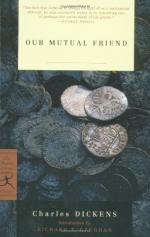|
This section contains 3,678 words (approx. 13 pages at 300 words per page) |

|
SOURCE: “Dickens and Our Mutual Friend: Fancy as Self-Preservation,” in Etudes Anglaises, Vol. 38, No. 3, July-September, 1985, pp. 257-65.
In the following essay, Collins examines the therapeutic quality of Dickens's use of fancy and imagination in Our Mutual Friend, and suggests that this is reflective of the author's preoccupation with his own dwindling creative powers.
For J. Hillis Miller Dickens's attention to the “otherness of elemental matter” in Our Mutual Friend (1864-65) functions as a kind of anti-transcendental vision: “the river, the dust, the wind, and the fire are what they are: mere matter.” They “are not symbols, if that means expressions of some reality which transcends them, and for which they stand.”1 Yet transcendence and renewal, as Miller well realises, are part of the very fabric of Our Mutual Friend, their presence inseparable from the novel's concern with a world of remorseless physical disintegration. Inseparable from this same “Gestalt...
|
This section contains 3,678 words (approx. 13 pages at 300 words per page) |

|


